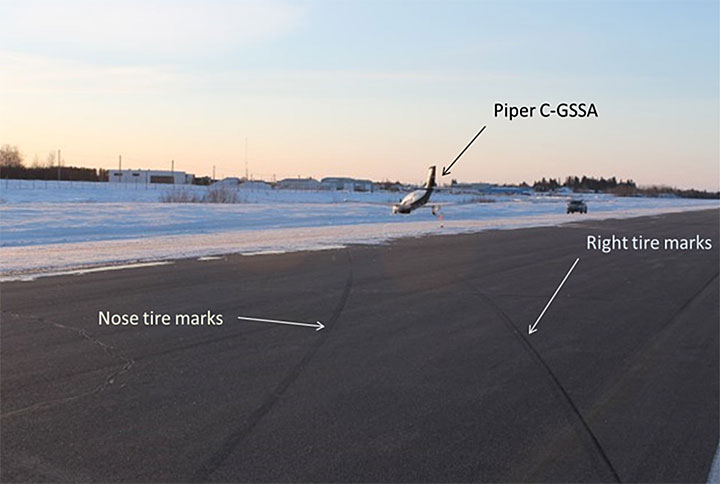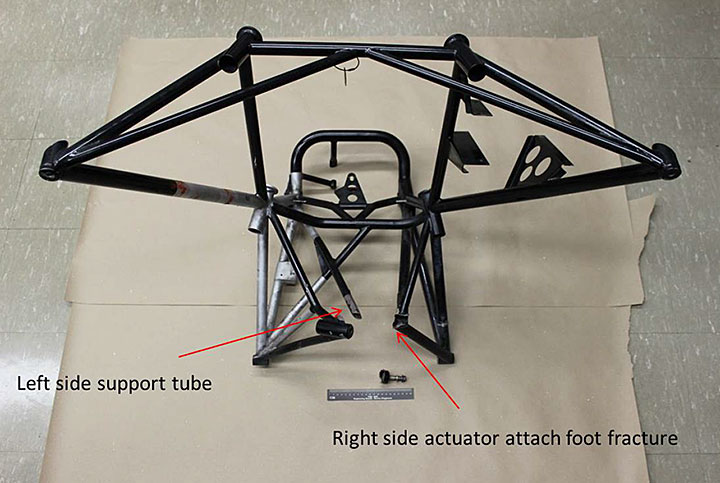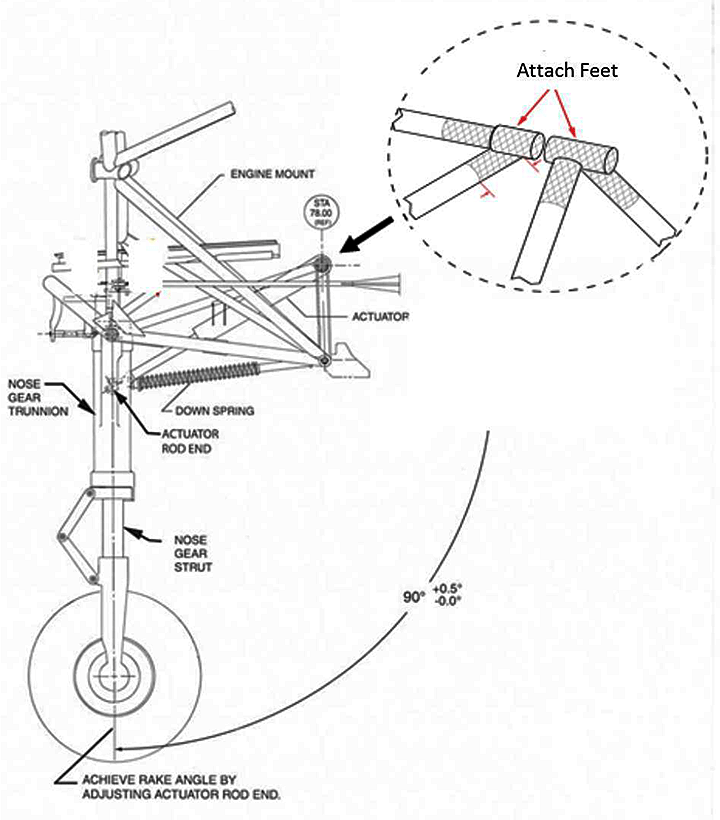Runway excursion
Piper Malibu Mirage PA-46-350P, C-GSSA
Alma, Quebec
The Transportation Safety Board of Canada (TSB) investigated this occurrence for the purpose of advancing transportation safety. It is not the function of the Board to assign fault or determine civil or criminal liability. This report is not created for use in the context of legal, disciplinary or other proceedings. See Ownership and use of content. Masculine pronouns and position titles may be used to signify all genders to comply with the Canadian Transportation Accident Investigation and Safety Board Act (S.C. 1989, c. 3).
Summary
On 23 January 2014, the privately operated Piper PA-46-350P Malibu Mirage (registration C-GSSA, serial number 4636518) departed Montréal International (Mirabel) Airport, Quebec, at 0848 Eastern Standard Time, for Alma, Quebec, with 1 pilot and 1 passenger on board. The flight was uneventful, and the aircraft landed at 1002 on Runway 31. As the nose wheel contacted the runway, directional control was lost. The aircraft veered left and departed the runway surface 400 feet after the loss of control. The aircraft came to a stop about 100 feet from the runway edge in a compacted snow bank, approximately 2200 feet from the threshold of Runway 31. There were no injuries. The aircraft was substantially damaged. There was no fire. The impact forces were not enough to activate the 406 megahertz emergency locator transmitter.
Factual information
History of the flight
On 23 January 2014, the aircraft departed Montréal International (Mirabel) Airport, Quebec, (CYMX) at 0848Footnote 1 with a pilot and passenger. The uneventful instrument flight rules flight was conducted at a cruising altitude of 15 000 feet above sea level. While on approach to Runway 31 at Alma, Quebec (CYTF), the pilot extended the landing gear and all indications were of a normal landing gear extension, including 3 green gear lights on the instrument panel.
The aircraft touched down on the centreline of the runway at 1002:03 at a ground speed of 74 knots. During the landing roll, at 1002:14, as the nose wheel contacted the dry runway surface, the aircraft veered momentarily to the right, and at 1002:16 uncontrollably to the left, exiting the runway. Once off the runway, the nose gear collapsed causing substantial aircraft damage. The aircraft came to a stop in a compacted snow bank at 1002:23. Neither the pilot nor the passenger sustained any injuries.
The data analysis showed that during the landing roll, as more weight came to bear on the nose gear, the aircraft started to turn left which the pilot attempted to correct with the rudder pedals and right brake. The tire marks from both the nose tire and the right main tire were clearly visible on the runway after the occurrence (Photo 1).
The aircraft sustained damage to the engine cowling, propeller, nose gear doors, and leading edges including wrinkle deformation on both wings. The sudden stopping of the engine and displacement of the engine mount from the impact caused a significant depression in the firewall.
Pilot
Records indicate that the pilot was certified and qualified for the flight in accordance with existing regulations. The pilot had accumulated approximately 1500 hours total time and 610 hours on the PA-46, and had attended many flight training programs including Piper's PA-46 Malibu Mirage course.
Weather
No aviation routine weather report (METAR) was issued for CYTF. The 2 closest aerodromes that issue METARs are Roberval (CYRJ), located 25 nautical miles (nm) to the west, and Bagotville (CYBG), 28 nm to the east. The 1000 METARs for CYRJ and CYBG were as follows:
- CYRJ: wind from 310 ° True (T) at 14 knots, visibility 40 statute miles (sm), few clouds at 9000 feet above ground level (agl) and broken clouds at 22 000 feet agl, temperature −24°C, dew point −30°C, and altimeter setting 30.02 inches of mercury (inHg).
- CYBG: wind from 280 ° T at 10 knots, visibility 25 sm, few clouds at 8000 feet agl and broken clouds at 24 000 feet agl, temperature −24°C, dew point −30°C, and altimeter setting 30.00 inHg.
CYTF uses an Automated Weather Advisory Station (AWAS) system for advisory purposes only. The AWAS was indicating as follows at 0948, about 14 minutes before the occurrence:
- CYTF: wind 330° T at 9 knots, visibility 10 sm, scattered clouds at 4200 feet agl, temperature −24.5°C.
The runway surface condition,a 90-foot-wide strip along the centreline was 95% bare and dry, with a 5% trace of dry snow, and the remainder of the runway was 100% ice.
Aircraft
The Piper Malibu Mirage is a low-wing, pressurized aircraft powered by a Textron Lycoming TIO-540-AE2A 350-horsepower engine. Production of the Piper Malibu Mirage commenced in October 1988. C-GSSA was manufactured in 2010 and was imported in Canada as new in November 2011. A certificate of airworthiness was issued on 27 November 2011.
Records indicate that the aircraft was certified, equipped, and maintained in accordance with existing regulations and approved procedures.The last annual inspection on C-GSSA was carried out in November 2013. At that time, the aircaft had accumulated 575 hours since new. At the time of the occurrence, the aircraft had accumulated 610 hours since new and approximately 385 cycles.
The aircraft was equipped with a Garmin 1000 avionics package that includes 2 display units, 1 serving as a Primary Flight Display (PFD) system and 1 as a Multi-Function Display (MFD). The PFD and MFD both have slots for SD cards. One slot is used to update the Jeppesen aviation database and to load software and configuration to the system. Another slot houses the world terrain and Jeppesen obstacle databases. SD cards were provided to the TSB, and contents of raw data flight information were used for flight animation and parameters analysis. The SD cards indicated that the aircraft was operated in accordance with Piper specifications.
Nose landing gear actuator and engine mount
Nose landing gear function
The nose landing gear (NLG) actuator on Piper-46-350P airplanes is bolted via 2 attach feet to the lower aft engine mount, which is constructed of welded tubes. The NLG actuator extends down and forward from the attach feet (Appendix A) and attaches to the NLG. During taxi, takeoff, and landing, the attach feet transmit loads from the NLG to the engine mount, thus creating repetitive stress in the engine mount attach feet areas and, in some cases, leading to fatigue cracking. Mounted on top of the nose gear trunnion are 2 nylon rollers which are used to translate the rotation of the steering arm from rudder pedals movements into rotation of the nose wheel.
The nose gear down lock switch is integral to the NLG actuator. A failure of the NLG actuator attach feet area could prevent the NLG from extending fully forward and the nose wheel from completely aligning with the longitudinal axis of the aircraft. It could also provide the pilot with a nose gear fully extended indication, not simply an actuator fully extended position. FAR23.729 and CARs 523.729 stipulate that switches must be located and coupled to the landing gear mechanical system in a manner that prevents an erroneous indication of down and locked position.
TSB Laboratory examination
C-GSSA was equiped with the original engine mount installed at the time of manufacture. The investigation revealed that the right side actuator attach foot fractured mainly in overstress from a pre-existing fatigue crack located at the toe of the weld which attaches the right side actuator foot to the support tubes (Photo 2).
The pre-existing fatigue crack measured approximately 13 mm in length and 0.25 mm at its deepest point. No metallurgical anomalies were observed in the engine mount that could have contributed to the formation of the fatigue crack. It could not be determined if the pre-existing fatigue crack was present at the time of the non-destructive testing (NDT) inspection, performed during the annual inspection 35 hours prior to the NLG actuator attach foot failure.
The failed engine mount has structures common to the landing gear system, and it was a landing gear component that failed. The structural integrity of the engine mount was not compromised with respect to engine/airframe attachment.
Preventive and regulatory actions
Transport Canada (TC) Canadian Civil Aircraft Register indicates that there are 28 registered PA-46 airplanes in Canada, and the Federal Aviation Administration (FAA) registry indicates roughly 940 registered PA-46 airplanes in the United States. An inquiry of the FAA's accident/incident database indicated that approximately 50 accidents/incidents have occurred since 1990 with similar sequences of events. The Service Difficulty Reports (SDR) system shows that, since production began, at least 25 engine mounts have been replaced due to cracks discovered during inspection.
On 08 April 2010, the National Transportation Safety Board (NTSB) recommended that the FAA
- require repetitive inspections for fatigue cracking of the nose landing gear actuator attachment foot areas on all PA-46-310 and -350P engine mount and require replacement, if necessary (A-10-44);
- require Piper to redesign the PA-46-310 and -350P engine mounts so that they are not susceptible to fatigue cracking in the attachment foot areas (A-10-45).
National Transportation Safety Board (NTSB) Recommendation A-10-44
Piper Aircraft Inc. issued Service Bulletin (SB) No. 1103D on 02 February 2011 in which it mandated certain PA-46 engine mount part numbers to be inspected following 290 hours of time-in-service since new, and other part numbers at 740 and 850 hours of time-in-service since new along with subsequent recurring 100 hours inspection mandate. There are no cycle inpection limits in the SB.
SBs are notices from a manufacturer notifying aircraft operators of a product improvement. In Canada and in the United States, an SB is not mandatory for private owners. The majority of Piper PA-46-350 aircraft are privately registered.
Alert service bulletins are issued by some manufacturers when a condition exists that the manufacturer feels is a safety-related item as opposed to just a product improvement. These SBs usually result in the FAA issuing an Airworthiness Directive (AD). The AD will reference the alert service bulletin as a method of compliance with the AD. Unless referenced in an AD, an SB or an alert SB is optional and may or may not be incorporated by the operator.
ADs are issued by the national civil aviation authority either of the country of aircraft manufacture or of aircraft registration. When ADs are issued by the country of registration, they are almost always coordinated with the civil aviation authority of the country of manufacture to ensure that conflicting ADs are not issued.
The purpose of an AD is to notify aircraft owners that
- the aircraft may have an unsafe condition;
- the aircraft may not be in conformity with its basis of certification or of other conditions that affect the aircraft's airworthiness;
- there are mandatory actions that must be carried out to ensure continued safe operation; and
- in some urgent cases, the aircraft must not be flown until a corrective action plan is designed and carried out.
ADs are mandatory in most jurisdictions and often contain dates or aircraft flying hours by which compliance must be completed.
The FAA is the responsible aviation authority for many United States aircraft types registered in Canada. Consistent with the TC/FAA Bilateral Airworthiness Agreement and TC regulations, ADs issued by the FAA against aircraft for which it is the responsible authority are mandatory in Canada, unless superseded by a TC AD.
The Canadian Aviation Regulations (CAR) 605.84 stipulates that an aircraft shall not be flown unless it is maintained in accordance with the requirements of any ADs issued by TC or the appropriate foreign aviation authority.
With regard to the applicability of foreign ADs, Standard 625 Appendix H, section 2, states, in part, “CAR 605.84 recognizes the mandatory status of foreign ADs and equivalent notices issued by the aviation authority that has jurisdiction over the type design of the aeronautical product.”Footnote 2
During the last annual inspection and as requested by the owner, the engine mount was inspected in accordance with SB 1103D part 1 using a fluorescent penetrant inspection (FPI), even though that inspection was only due at 740 hours. No crack was detected by the NDT inspection. The aircraft was always maintained by an approved Piper authorized service centre.
Piper Aircraft Inc. issued revised SB No. 1103E on 05 June 2014. This SB identifies a new replacement engine mount for all PA-46-350P and PA-46-350T airplanes which, when installed, eliminates the recurring 100-hour inspection. Also, the initial inspection time for all Malibu Mirage and Matrix airplanes has been reduced to 200 hours, with a recurring inspection not to exceed each 100 hours time in service.
On 14 July 2014, the FAA issued Special Airworthiness Information Bulletin (SAIB) number CE-09-13R1 to alert owners and operators of an airworthiness concern, specifically relating to possible cracks in the engine mount of Piper models PA-46-310P, PA-46-350P, PA-46-350T and PA-46-500TP airplanes. The SAIB emphasizes the importance of compliance with Piper SBs 1103 and 1154. The FAA recommends to inspect the engine mount and, if cracks are found, to replace it with a new mount. Currently, the airworthiness concern is not considered an unsafe condition that would warrant airworthiness directive (AD) action under Title 14 of the Code of Federal Regulations (14 CFR) part 39.
TSB Laboratory reports
The following TSB Laboratory report was completed:
- LP085/2014 - Examination of Engine Mount
Analysis
There is no indication that the pilot's performance was an issue during this event. Data obtained from SD cards showed that the aircraft was operated in accordance with Piper specifications.
The sequence of events in this occurrence is consistent with a failure of the engine mount's nose landing gear actuator attach foot which prevented the nose gear from extending fully forward and the nose wheel/tire from completely aligning with the airplane's longitudinal axis. Therefore, the analysis will focus on aircraft components that played a role in the occurrence, and mitigation measures taken by the aircraft manufacturer.
The occurrence aircraft has always been maintained by a Piper authorized service centre. Because of a history of engine mount nose landing gear actuator attach feet cracks, Service Bulletin (SB) 1103D was carried out as a precautionary measure during the last annual inspection. The aircraft had flown only 35 hours since the inspection. The investigation determined that the right side actuator attach foot fractured mainly in overstress from a pre-existing fatigue crack due to an inadequate engine mount design to support its loading requirements. However, it could not be determined if the fatigue crack was present when the last annual inspection was carried out.
During the landing gear down selection, a 3-green indication was received in the cockpit, misleadingly indicating to the pilot that the nose gear was safely in the down and locked position. Unaware that the nose gear was not fully down and locked, the pilot continued with the landing which resulted in the runway excursion.
The investigation determined that a crack may appear before the original inspection criterion of 740 hours. Piper Aircraft Inc. issued SB 1103E on 05 June 2014, changing the inspection period to 200 hours. This new criterion may help discover fatigue cracks. If cracks are found during the inspection, Part 2 of the safety bulletin mandates replacement with a new strengthened engine mount, which is also recommended by the FAA through the Special Airworthiness Information Bulletin issued on 14 July 2014. However, if the requirements prescribed in SB 1103E are not made mandatory for operators in Canada, then there is a continued risk that fatigue cracks may not be discovered in a timely manner to prevent a similar occurrence.
Findings
Findings as to causes and contributing factors
- The pilot was provided with a safe gear down and locked indication despite an unsafe nose gear position. Unaware that the nose gear was not fully down and locked, the pilot continued with the landing which resulted in the runway excursion.
- The right side actuator attach foot fractured mainly in overstress from a pre-existing fatigue crack due to an inadequate engine mount design to support its loading requirements.
- Failure of the engine mount's nose landing gear actuator attach foot prevented the nose gear from extending fully forward and the nose wheel/tire from completely aligning with the airplane's longitudinal axis. Consequently, the aircraft veered to the left as the nose wheel contacted the runway surface which resulted in the runway excursion.
Findings as to risk
- If the requirements prescribed in Service Bulletin 1103E are not made mandatory for operators in Canada, then there is a continued risk that fatigue cracks may not be discovered in a timely manner to prevent a similar occurrences.
This report concludes the Transportation Safety Board's investigation into this occurrence. the Board authorized the release of this report on . It was officially released on .


